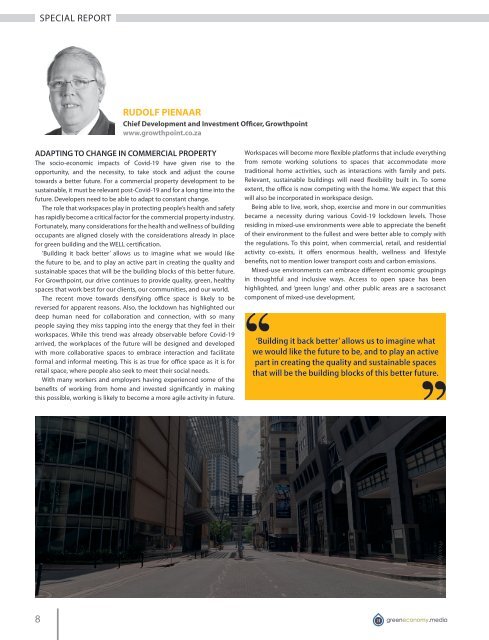Green Economy Journal Issue 41
Create successful ePaper yourself
Turn your PDF publications into a flip-book with our unique Google optimized e-Paper software.
SPECIAL REPORT<br />
Rudolf Pienaar<br />
Chief Development and Investment Officer, Growthpoint<br />
www.growthpoint.co.za<br />
ADAPTING TO CHANGE IN COMMERCIAL PROPERTY<br />
The socio-economic impacts of Covid-19 have given rise to the<br />
opportunity, and the necessity, to take stock and adjust the course<br />
towards a better future. For a commercial property development to be<br />
sustainable, it must be relevant post-Covid-19 and for a long time into the<br />
future. Developers need to be able to adapt to constant change.<br />
The role that workspaces play in protecting people’s health and safety<br />
has rapidly become a critical factor for the commercial property industry.<br />
Fortunately, many considerations for the health and wellness of building<br />
occupants are aligned closely with the considerations already in place<br />
for green building and the WELL certification.<br />
‘Building it back better’ allows us to imagine what we would like<br />
the future to be, and to play an active part in creating the quality and<br />
sustainable spaces that will be the building blocks of this better future.<br />
For Growthpoint, our drive continues to provide quality, green, healthy<br />
spaces that work best for our clients, our communities, and our world.<br />
The recent move towards densifying office space is likely to be<br />
reversed for apparent reasons. Also, the lockdown has highlighted our<br />
deep human need for collaboration and connection, with so many<br />
people saying they miss tapping into the energy that they feel in their<br />
workspaces. While this trend was already observable before Covid-19<br />
arrived, the workplaces of the future will be designed and developed<br />
with more collaborative spaces to embrace interaction and facilitate<br />
formal and informal meeting. This is as true for office space as it is for<br />
retail space, where people also seek to meet their social needs.<br />
With many workers and employers having experienced some of the<br />
benefits of working from home and invested significantly in making<br />
this possible, working is likely to become a more agile activity in future.<br />
Workspaces will become more flexible platforms that include everything<br />
from remote working solutions to spaces that accommodate more<br />
traditional home activities, such as interactions with family and pets.<br />
Relevant, sustainable buildings will need flexibility built in. To some<br />
extent, the office is now competing with the home. We expect that this<br />
will also be incorporated in workspace design.<br />
Being able to live, work, shop, exercise and more in our communities<br />
became a necessity during various Covid-19 lockdown levels. Those<br />
residing in mixed-use environments were able to appreciate the benefit<br />
of their environment to the fullest and were better able to comply with<br />
the regulations. To this point, when commercial, retail, and residential<br />
activity co-exists, it offers enormous health, wellness and lifestyle<br />
benefits, not to mention lower transport costs and carbon emissions.<br />
Mixed-use environments can embrace different economic groupings<br />
in thoughtful and inclusive ways. Access to open space has been<br />
highlighted, and ‘green lungs’ and other public areas are a sacrosanct<br />
component of mixed-use development.<br />
‘Building it back better’ allows us to imagine what<br />
we would like the future to be, and to play an active<br />
part in creating the quality and sustainable spaces<br />
that will be the building blocks of this better future.<br />
Photo by Ihsaan Haffejee<br />
8 greeneconomy.media


















